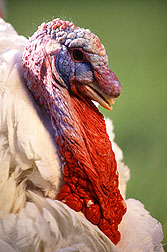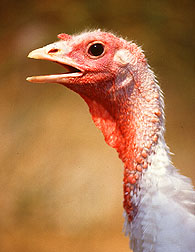

Successful fly control is accomplished through the integration of nonchemical and chemical control methods. Reliance on the use of insecticides alone seldom results in satisfactory fly control. SANITATION AND MANURE MANAGEMENT is very important. Ideally, manure should be removed at least twice each week to remove fly breeding materials. Spread manure thinly with a flail-type spreader to allow drying and to prevent the completion of fly development in the field. At least 450 flies can breed in one pound of manure which is why THOROUGH CLEANUP is essential.
If manure is allowed to build up, MOISTURE CONTROL is essential to insure that it dries rapidly. Proper ventilation, temperature control, cutting of grass and weeds around buildings and use of fans to increase air movement over droppings will enhance drying. Keep waterers from leaking, cull birds that habitually produce very loose manure, remove broken eggs and dead birds and reduce feed spillage to improve fly control.
Proper use of SCREENING on all doors and windows will keep flies out of egg rooms and offices. Air curtains and properly positioned fly electrocuter traps are also useful in preventing flies from entering buildings.
Chemical fly control measures are a necessary part of a successful fly control program. Residual sprays and baits will give up to six weeks control. When large numbers of adult flies are present in untreated areas, the use of contact fogs, mists, and space sprays will provide rapid but short term suppression of the population. Fogs, mists, space sprays and residual sprays are also useful for controlling mosquitoes in poultry houses.
Larvicides sprayed directly onto accumulated droppings will give some control but removal or controlling the moisture in the droppings is preferable. Insecticide feed additives (Larvadex) are also available which, when incorporated into the feed, pass through the bird and prevent larval development in the droppings.
| Insecticide | Amount |
| Pyrethrins (0.1 to 0.6%) plus Piperonyl Butoxide (1 to 6%) | Ready-to-Use |
| Dibrom 37% EC (naled) | 1 cup/10 gal water |
Pyrethrins: Apply for 5-6 sec/1000 cu ft as a fog when flies are present. Keep room closed for 15 minutes following application. Use as necessary. DO NOT contaminate feed or water or spray birds directly. Various types of aerosol, mist, and ULV (ultra low volume) equipment are available for making these applications.
Residual Fly Sprays
Insecticides may be applied as residual surface sprays, non-residual space sprays, baits, manure sprays, or feed additives.
Always read and follow label instructions before applying insecticides for fly control. Treat walls, ceilings, posts, and
other fly resting sites. Spray these areas thoroughly and to the point of runoff. In order to minimize control failures
due to insecticide resistance, do not apply the same insecticide, or insecticide within the same chemical class
(particularly pyrethroids), repeatedly throughout an entire season. See product labels for use rates.
| Synthetic Pyrethroid Insecticides | Organophosphate Insecticides |
| cyfluthrin - Countdown 2 EC or 20% WP or Tempo 2E | stirofos - Rabon 50% WP |
| fenvalerate - Ectrin 10% WDL | stirofos + vapona Ravap EC |
| lambda-cyhalothrin - Grenade 10% WP | |
| permethrin - Atroban 25% WP or 11% EC, Ectiban 7% EC or WP, Expar, Gardstar, Insectaban, Insectrin, Overtime, Permaban, Permectrin II 10% or 25% WP | |
Fly Parasite Release Programs
Several commercial firms offer a fly parasite release program that can be used to supplement fly control around
concentrated livestock operations. These small wasp parasites attack house flies or stable flies. The benefits of
parasite release programs in livestock operations have not yet been proven. Several parasite species are available.
Spalangia nigroaenea attacks house flies and stable flies in feedlots. Parasites in the genus Muscidifurax attack
house flies while those in the genus Spalangia attack stable flies. Do not buy blends of unknown species and do not
buy shipments of Nasonia vitripennis, a species that has been ineffective in midwestern feed lots.
See ENTFACT 502- "Biological Control of Flies".
Fly Traps
Large numbers of flies can be caught in baited fly traps but the traps do not cause any significant reduction in total fly
numbers. In addition, this approach does nothing to eliminate fly breeding sites. Electrocuting light traps may reduce
house fly and stable fly numbers in closed buildings.
Fly baits can be scattered where house flies congregate to provide some temporary reduction in numbers. Never use baits where cattle or other domestic livestock can eat them. Place baits in areas where flies congregate, such as window sills or doorways. Baits alone will not control fly populations. They should be used along with sanitation and other insecticidal methods (e.g., residual and space sprays). Baits containing the active ingredient methomyl include Apache, Golden Malrin Fly Bait Plus, and Tailspin. Dipterex 1% Bait contains trichlorfon.
Never use baits where loose birds are housed or in areas accessible to poultry. Place baits in pans or protected locations where flies congregate such as window sills or doorways. Indiscriminant scattering of bait is wasteful and unnecessary. For maximum effect, baits should be used in conjunction with other chemical or nonchemical approaches. Read the label for further instructions.
Manure sprays kill fly larvae that are developing in treated areas. They are recommended where manure cannot
be removed on a 7 to 10 day schedule. Apply at a rate of approximately 1 gal/100 sq. ft. to kill maggots. Do not spread
treated manure onto crops not listed on the insecticide label. Apply sprays at rates that wet the manure surface, it is
not necessary to soak the manure. Repeat treatments as necessary but no more often than every 7 days.
Rates to
use in per 25 gallons of water include:
Use larvicides strictly according to the label. Insure that there is thorough but not excessive coverage and penetration of droppings to achieve control. Larvicides are designed to be used in caged bird houses only.
| Insecticide | Amount |
| Golden Malrin Liquid 24.8% EC (dimethoate + DDVP) | 1 gal/20 gal water |
| Rabon 50% WP Rabon 24% EC |
2.5 oz/gal water/100 sq. ft. 6 oz/gal water/100 sq. ft. |
| Ravap 28.7% EC | 5 oz/gal water/100 sq. ft. droppings |
Larvadex Premix (cromazine) can be used as a feed through larvicide on for caged layer hens. Use at 1 pound per ton of feed for house fly control or 3-1/3 pounds per ton for little house fly control.
Several commercial firms offer a fly parasite release program that can be used to supplement fly control around
concentrated poultry operations. These small wasp parasites lay their eggs in the larvae or pupae of house flies.
For optimum results, a parasite release program must be instituted on locations where excellent manure
management and sanitation has already reduced the fly population. In addition, the proper species of parasite
must be released regularly and in large numbers. However, at this time it is not known when, how many, and
which species of fly parasites to release for optimum results.